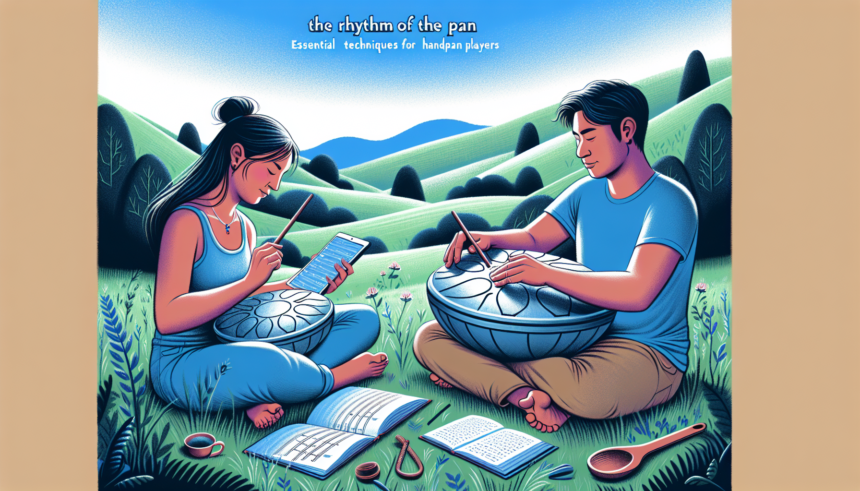The handpan is a captivating and relatively novel musical instrument that has enraptured musicians and listeners alike with its ethereal sound. For those who are new to the handpan or looking to refine their skills, there are essential techniques and tips that can greatly enhance one’s playing ability. This article delves into the fundamental aspects of handpan playing, providing insights that every handpan enthusiast should know.
Understanding the Handpan
The handpan, often referred to as a ‘Hang Drums’, is a convex steel drum played with the hands and fingers. It was developed in the early 21st century, drawing inspiration from traditional percussion instruments. The handpan typically consists of a central note called the Ding, surrounded by a circle of tone fields, each producing different pitches.
Setting the Foundation: Proper Posture
Before diving into techniques, it is crucial to establish a comfortable playing posture. The handpan is usually played while seated. Place the instrument on your lap, ensuring it rests securely. Your back should be straight, and your shoulders relaxed. This posture not only prevents strain but also allows for better control over your movements.
Striking Techniques
One of the most vital aspects of playing the handpan is mastering the art of striking. The way you strike the handpan significantly affects the sound produced. Here are a few techniques to consider:
Fingertip Striking
Using your fingertips to strike the handpan is a common method for producing crisp and clear tones. Ensure that you strike the surface gently but firmly, allowing the note to resonate fully.
Slap Technique
This technique involves striking the handpan with the side of the fingers or the palm. It produces a sharper, more percussive sound, adding variety to your playing.
Thumb Striking
Using the thumbs can create subtle and soft sounds, perfect for creating dynamic variations in your performance.
Hand Coordination and Rhythm Practice
Ensuring both hands are well-coordinated is fundamental for smooth and rhythmic playing. Start with simple exercises, alternating between hands while maintaining a steady rhythm. Here are some effective exercises:
- Alternating Strikes: Play back and forth between the Ding and one of the tone fields, focusing on even timing and consistent sound quality.
- Hand Independence: Practice patterns where one hand maintains a steady beat while the other hand plays various rhythms across the tone fields.
Creating Melodic Patterns
Once you’ve got the basics down, it’s time to explore melodic patterns. Understanding scales and patterns on the handpan can open up endless possibilities for creative expression.
Scale Familiarity
Handpans are typically tuned to a specific scale. Familiarize yourself with the scale your handpan is tuned to and practice playing up and down the scale smoothly.
Pattern Repetition
Developing sequences of notes and repeating them helps in building musical phrases. Start with simple patterns and gradually incorporate more complexity.
Dynamics and Expression
Playing with dynamics and expressiveness is what makes handpan music beautifully emotive. Here are some tips to infuse your playing with feeling:
Volume Control
Practice playing at different volumes. Gentle touches can create soft and soothing sounds, while stronger strikes can produce powerful and resonant tones.
Tempo Variations
Experiment with varying the tempo to add emotion to your playing. Gradually speed up or slow down to create tension and release.
Advanced Techniques
For those who have mastered the basics and are looking to advance their skills, here are some advanced techniques to explore:
Harmonic Taps
By lightly touching specific spots on the handpan while striking a note, you can create harmonic overtones. This technique adds a rich layer of sound to your playing.
Muting
Using your fingertips to quickly silence a note after striking it can produce rhythmic and percussive effects. This technique is great for adding texture to your music.
Improvisation and Creativity
Improvisation is at the heart of handpan playing. It encourages creativity and personal expression. Here are some tips for improvising:
- Free Exploration: Spend time freely exploring the handpan without premeditated ideas. Let your fingers wander and see what melodies and patterns emerge.
- Incorporate Influences: Draw inspiration from other music genres and instruments, blending different styles into your handpan playing.
Recording and Sharing Your Music
Recording your handpan sessions is an excellent way to track your progress and share your music with a wider audience. Here are some tips for capturing high-quality recordings:
Choosing the Right Environment
Find a quiet space with good acoustics. Avoid environments with too much echo or background noise.
Microphone Placement
Place your microphone at a distance where it can capture the full resonance of the handpan. Experiment with different angles and distances to find the optimal position.
Joining the Handpan Community
Part of the joy of playing the handpan is connecting with other enthusiasts. Joining handpan communities can provide support, inspiration, and opportunities for collaboration. Here are a few ways to get involved:
Online Forums
Join online forums and social media groups dedicated to handpan players. These platforms are valuable resources for exchanging tips, sharing music, and finding fellow musicians.
Workshops and Gatherings
Attend handpan workshops and gatherings in your area. These events often feature instructional sessions, performances, and opportunities to play alongside others.
Maintenance and Care
Proper maintenance is essential to keep your handpan in top condition. Here are some tips:
Cleaning
Regularly wipe down your handpan with a soft, dry cloth to remove dust and fingerprints. Avoid using harsh chemicals.
Storage
Store your handpan in a cool, dry place, ideally in a padded case to protect it from bumps and scratches.
Conclusion
Playing the handpan is a deeply rewarding experience that combines rhythmic precision, melodic creativity, and expressive dynamics. By mastering the essential techniques and embracing continuous practice, you’ll unlock the full potential of this enchanting instrument. Remember, the journey of learning an instrument is as beautiful as the destination. Stay patient, stay curious, and let the rhythm of the pan guide you on a musical adventure.
FAQs
1. How long does it take to learn the handpan?
The time it takes to learn the handpan varies widely based on individual dedication and practice consistency. Beginners can start playing simple melodies within a few weeks, but mastering advanced techniques can take several years.
2. Do I need musical background to play the handpan?
No prior musical background is necessary to learn the handpan. Its intuitive design and layout make it accessible to musicians of all levels, including complete beginners.
3. How do I choose the right handpan for me?
Choosing a handpan involves considering factors like scale, material, and budget. It’s beneficial to try different handpans if possible and see which one resonates with you the most.
4. Can handpan be played in a band or ensemble?
Yes, the handpan can be a versatile addition to a band or ensemble, providing unique tones that complement other instruments. Its calming sound pairs well with both acoustic and electronic elements.
5. Is it possible to self-learn the handpan?
Absolutely! There are numerous online resources, tutorials, and communities that can aid you in self-learning. However, attending workshops or taking lessons can provide valuable guidance and accelerate your progress.





